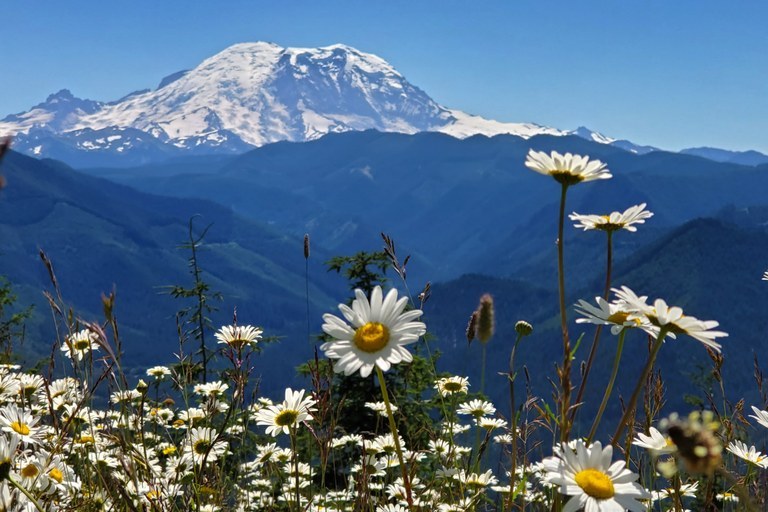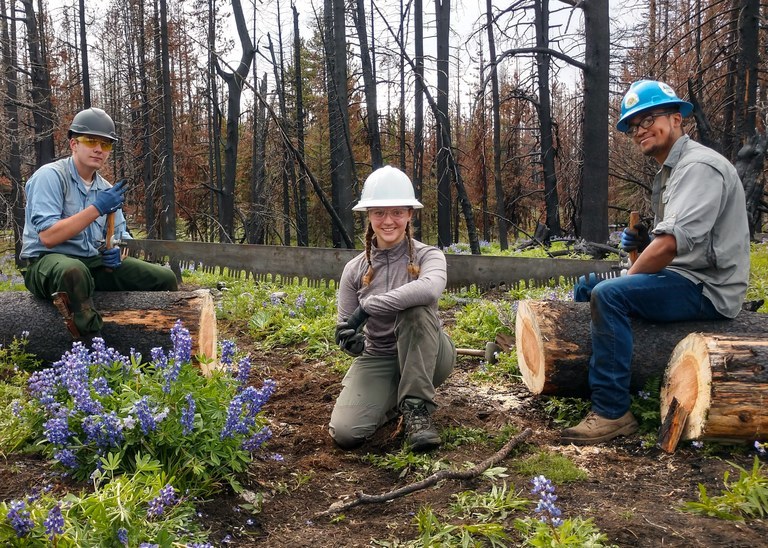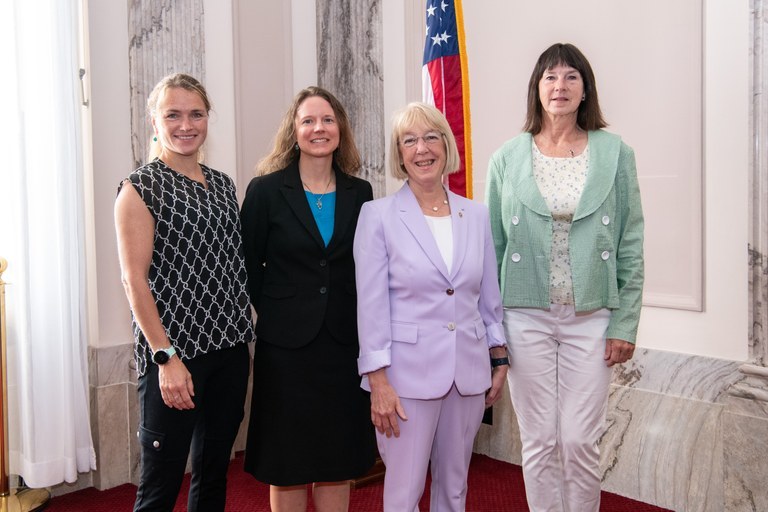How Powerful Partnerships Help WTA Build a Better Future for Trails
WTA has been bringing people together for years. By building connections, finding middle ground and creating shared goals, we are moving toward our vision of trails for everyone, forever. Here are a few recent examples of how, when we come together, we can do more for trails and the hiking community.
If you've ever built a rock wall with WTA, you have likely encountered the unassuming but powerful rock net, a simple tool that allows a group of volunteers to move heavy rocks that they could never manage alone.
At WTA, our tool cache is vital to our work on trail — but we have many more tools at our disposal. Some of our most powerful instruments of change — coalitions and collaborations — look just as unassuming as the humble rock net. By working together, WTA and the many organizations that protect the outdoors are able to get more done than any group could on their own. Together, we can do great things for the future of Washington’s trails.

Just like a rock net makes heavy work easier, collaborating with other outdoor organizations helps WTA get more work done. Photo by Britt Lê.
For years, WTA has been bringing together people and ideas by building connections, finding middle ground and creating shared goals. These collaborations are moving us toward our vision of trails for everyone, forever. Here are just a few recent examples of how working together helps us do more for trails and the hiking community.
a shared vision and a shared workload
Washington is a big state with lots of wonderful trails that could use maintenance and investment. When we work with other organizations to create a shared vision for a place, we can get more done. One way we ensure that more trails receive care every year is by talking with other groups that do trail work — and then divvying up the work so that more trails are maintained. For example, if one group clears the feeder trail, then another group can go into the backcountry and get more work done farther back.

Snoquera is one of the areas WTA has been working with partners to create a strong plan for the future of recreation in the area. It's an easy day trip for many people in the Puget Sound region, giving it great potential to disperse use across trails. Photo by Jeremy Tarife.
Planning for the future of outdoor recreation also requires ongoing conversations among diverse groups. For example, we've been considering the future of the Snoquera region, one of the pilot projects for our Trails Rebooted campaign.
Recent fires and an ongoing landscape analysis by the U.S. Forest Service mean this is an ideal time to think about recreation in this area for decades into the future. In 2019, WTA co-hosted a field tour in Snoquera with Conservation Northwest and WildEarth Guardians. The 26 participants represented a wide variety of interests — from issues like salmon, fish and water (Trout Unlimited and Puget Sound Partnership) to tribes (the Tulalip Tribes of Washington and Muckleshoot Indian Tribe) to recreation groups (Evergreen Mountain Bike Alliance and Back Country Horsemen of Washington). These groups, along with other key decision makers, came together to learn about the area and envision its future.

PNTA Crew Leader, Carly Tryon, poses next to a freshly cleared blowdown with Jacob Pimpiano on the left and Adonis Haskins on the right. By working with partners in the Pasayten, we've been able to get much more work done. Photo by Sean Miller.
The work of collaboration doesn’t stop once you have a vision. Making that vision a reality requires ongoing coordination. WTA’s Lost Trails Found campaign has shown how much on-the-ground work can get done when we collaborate with other groups. For example, last summer the Forest Service and partner organizations such as Back Country Horsemen of Washington, Northwest Youth Corps and the Pacific Northwest Trails Association came together in a coordinated effort to make many trails in the Paysaten Wilderness accessible to hikers again.
The Teanaway Community Forest is yet another example of the power of collaborations — and how they can evolve over time. For nearly a decade, WTA has been working with groups around the state to help shape the future of the Teanaway, a unique forest in Washington where the spirit of collaboration is built into how this area is managed.
Stronger — and louder — Together
Hikers have a long history of speaking up for trails. And when you add in more recreation groups, land managers and organizations that are equally passionate about the outdoors — the voices of Washington's recreation leadership can be heard across the country.

Representatives from Evergreen Mountain Bike Association, Washington Trails Association and Back Country Horsemen of Washington meet with Sen. Patty Murray in Washington DC.
The Evergreen Mountain Bike Association and Back Country Horsemen of Washington are two groups we work with particularly closely. We have a long history of working together in the field, in Olympia and in our nation’s capital. We all want trails for hikers, bikers and horseback riders to enjoy but, most importantly, we all want sustainable trails and access to public lands for everyone. The effort of such trips paid off at the national level this year with the passage of the Great American Outdoors Act. And last year, at the state level, our work with Evergreen Mountain Bike Association and state agencies moved forward vital research showing that trails boost our economy and improve people's physical and mental health.
This same collaborative spirit helped inspire the Recreate Responsibly coalition earlier this year. When state lands began to reopen after the governor's Stay Home, Stay Healthy order, the Washington Recreate Responsibly Coalition was formed under the leadership of Washington Trails Association, outdoor retailer REI and state land managers. More than 70 organizations came together to create clear consistent guidelines to help everyone in our state get outside safely. And the work of the Washington coalition helped shape the national conversation.

GirlTrek, PNW Research Station social scientists and WTA came together to talk about barriers to getting out on trail. Photo courtesy Allie Tripp.
Expanding the Conversation
Sometimes the best thing you can do is make a connection and invite more people to the conversation. That is what WTA did when we heard the Forest Service was digging into what barriers were keeping folks from getting outside. We helped connect the forest service researchers with Seattle’s local branch of GirlTrek, a national nonprofit dedicated to the health and healing of Black women through walking. WTA connected with GirlTrek when they were looking for transportation support for their monthly hikes. The results of that study will help efforts to make the outdoors more accessible for everyone.
Another way we're amplifying the power of the outdoors is through our Outdoor Leadership Training program, which teaches leaders of youth organizations how to safely take their groups outdoors on everything from day hikes and snowshoe treks to weeklong backpacking trips.
Last year, we were excited to welcome a new OLT leader, Collin Tasaka, who is also a coordinator for Outdoor Asian and an Outdoor Wellness Leader at the University of Washington’s Bothell campus. Collin began with WTA as an attendee at one of our snowshoeing workshops. He enjoyed it so much that he completed all of our other courses. His skills and enthusiasm made him a great fit for the program and we asked him to join us a co-instructor. His experiences with OA and OWL helped make WTA's work even stronger by bringing new ideas and connections to the program. Collin and our other OLT instructors help spread a love for the outdoors — while showing youth leaders how to get outside safely.
Building the future
Whether we're lobbying our leaders in Washington, D.C., or working together to build a new trail system with our partners, the power of collaboration is helping us get more done. We are fortunate in Washington to have so many organizations (several dozen more than we could list today) that are passionate about our public lands and are committed to coming together to protect the places we love. We envision a future where there are trails for everyone, forever. We're so grateful for all of our partners who are helping to build that future. And thank you to all of our members who help make our work possible — we couldn't do it without you.


Comments